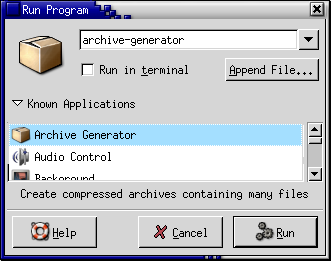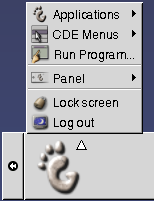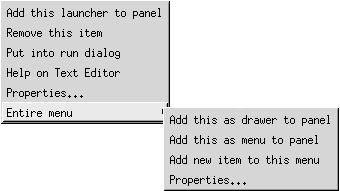Working With Menus
This chapter describes how to use menus in the desktop.
- I.5.1. Introduction to Menus
- I.5.2. Menu Features
- I.5.3. Applications Menu
- I.5.4. Actions Menu
- I.5.5. GNOME Menu
I.5.1. Introduction to Menus
You can access all desktop functions through menus. The default panels contain menus, so you can use a combination of menus and panels to perform your tasks. You can perform various actions on your menus, such as copy menu items to panels.
You can access the following menus from the desktop:
- menu: You can access many of the applications, commands, and configuration options on your desktop from the menu.
- menu: You can access various desktop commands from the menu. For example, you can start the Search Tool application, or log out from the desktop.
- : You can also access the items in the and menus from the . You can have many buttons in your panels.
You can also right-click on the desktop background to open the menu. The menu enables you to perform desktop background-related tasks. For information on the menu, see Chapter I.8 ― Using the Desktop Background.
All of these menus provide you with multiple ways to perform your tasks, and enable you to work in the way that you prefer.
I.5.2. Menu Features
Menus can contain the following items:
- Submenus
- Launchers
An arrow to the right of an item in a menu indicates that the item is a submenu. When you point to the submenu, the submenu opens. You can choose items from the submenu.
When you choose a launcher, the launcher starts an application or runs a command. You can also right-click on a launcher to open a popup menu. The popup menu enables you to add the item to a panel, and perform other tasks. For more information on the popup menu, see the next section.
You can change the theme for your session to change how all your menus look. To change the theme, choose .
- I.5.2.1. Launcher Popup Menu
I.5.2.1. Launcher Popup Menu
Launchers on menus have an associated popup menu that enables you to perform tasks related to launchers. When you right-click on a launcher in a menu, the popup menu for the launcher opens. The popup menu also contains a submenu that allows you to perform menu-related tasks.
You can use the launcher popup menu to perform the following tasks:
- Add launchers to panels.
- Remove launchers from menus.
- Open the Run Program dialog with the launcher command in the dialog.
- Add menus to panels. You can add a menu as a menu object or as a drawer object.
- Add new items to menus.
- Change the properties of submenus and launchers.
Some items in the popup menu might not be available to you. Your user privileges determine which items are available. For example, if you do not have system administrator privileges, you can not modify the properties of the menu.
Figure I.5-1 shows the popup menu.
Table I.5-1 describes the items on launcher popup menus.
| Item | Description |
|---|---|
| Adds the launcher to the panel from which you open the menu. | |
| Removes the launcher from the menu. | |
| Displays the Run Program dialog with the command from the Command field of the launcher in the command field on the Run Program dialog. | |
| Open the online help for the application. | |
| Displays a dialog that enables you to edit the properties of the launcher. | |
| Adds the submenu as a drawer to the panel from which you open the menu. | |
| Adds the submenu as a menu object to the panel from which you open the menu. | |
| Enables you to add an item to the submenu. | |
| Displays a dialog that enables you to edit the properties of the submenu. |
I.5.3. Applications Menu
The menu contains a hierarchy of submenus, from which you can start the standard GNOME applications and preference tools. The menu also includes the file manager and the help browser.
The menu resides in the following places:
- Menu Panel
- Start Here location in Nautilus
I.5.4. Actions Menu
The menu contains various desktop commands. Table I.5-2 describes the commands in the menu.
| Menu Item | Function |
|---|---|
| Opens the Run Program dialog. Use the Run Program dialog to run commands. For more information, see Section I.5.4.1 ― Using the Run Program Dialog. | |
| Starts the Search Tool application. For more information, see the Search Tool manual. | |
| Opens the Screenshot dialog. Use the Screenshot to take screenshots of your desktop. | |
| Locks your screen. For more information, see Section I.3.2 ― Locking Your Screen. | |
| Logs you out of the current session. For more information, see Section I.3.4 ― Ending a Session. |
The menu resides in the following places:
- Menu Panel.
- . The items in the menu are at the top level of the .
- I.5.4.1. Using the Run Program Dialog
I.5.4.1. Using the Run Program Dialog
The Run Program dialog gives you access to the command line. When you run a command in the Run Program dialog, you cannot receive output from the command.
To run a command from the command line perform the following steps:
-
Display the Run Program dialog. You can display the Run Program dialog in any of the following ways:
-
From the Menu Panel
Choose .
-
From the
Open the , then choose .
-
Use a shortcut key
The default shortcut key to display the Run Program dialog is Alt+F2. You can change the shortcut key that displays the Run Program dialog in the Desktop Preferences. To change the shortcut key, choose .
-
From a launcher popup menu
Right-click on a launcher in a menu, then choose Put into run dialog from the popup menu. The Run Program dialog opens with the command from the menu in the command field.
The Run Program dialog is displayed as follows:

-
-
Choose the command that you want to run from the applications drop-down combination box.
Alternatively, click on the button to display a list of available applications, as shown in the following figure:

Enter the command that you want to run in the blank field. Alternatively, to choose a command that you ran previously, click the down arrow button, then choose the command to run.
You can also use the button to choose a file to append to the command line. For example, you can enter emacs as the command, then choose a file to edit.
Select the Run in terminal option to run the application or command in a terminal window. Choose this option for an application or command that does not create a window in which to run.
Click on the button on the Run Program dialog.
I.5.5. GNOME Menu

You can access almost all of the standard applications, commands, and configuration options on your desktop from the .
The provides the following top-level menus and special menu items:
- : Contains all applications and preference tools. This menu also includes the file manager and help browser.
- : Contains desktop commands the and menu items. By default, the items in the menu are at the top level of the .
- launcher: Displays the Run Program dialog.
You can add buttons to your panels. By default, the is represented on panels by a stylized footprint icon, as follows:
- I.5.5.1. To Open the GNOME Menu
- I.5.5.2. To Add a GNOME Menu to a Panel
I.5.5.1. To Open the GNOME Menu
You can open the in the following ways:
-
From a panel with a
Click on the .
-
Use a shortcut key
You can use a shortcut key to open the . When you use a shortcut key to open the , the appears at the mouse pointer.
The default shortcut key to open the is Alt+F1. To change the shortcut key that opens the , choose .
